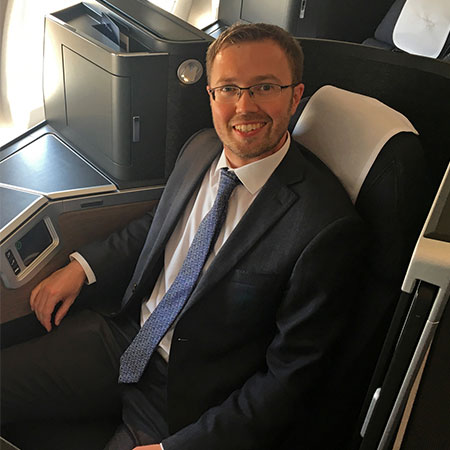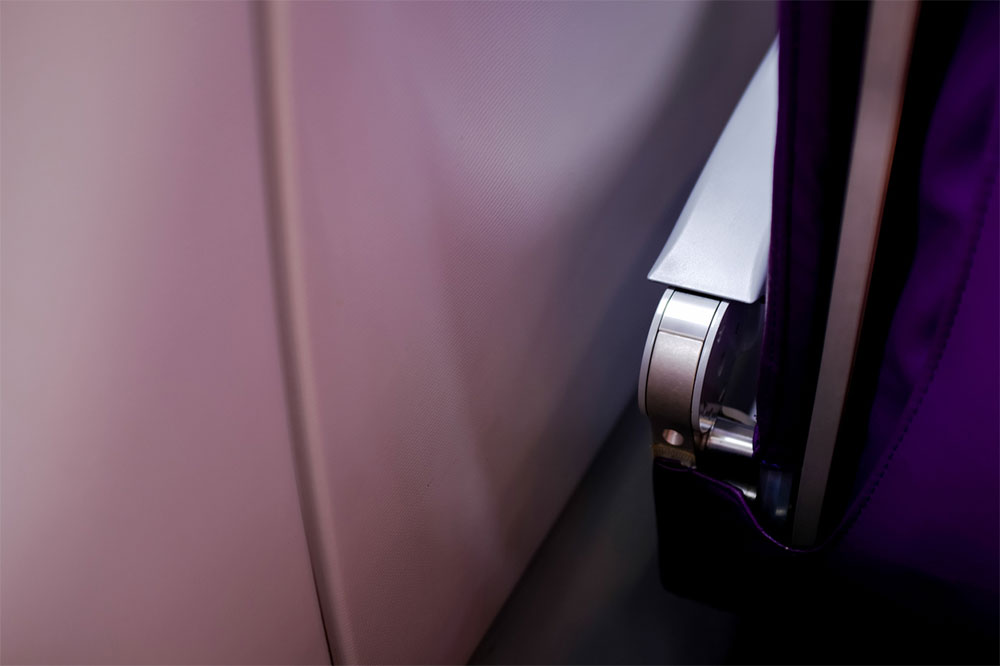- Aerospace
- Airline
- Expert view
Airlines chase the “sweet spot” cabin with Boeing 777-300ER retrofits
James Mellon examines the current wave of 777-300ER retrofits, analyzing what they reveal about cabin interior trends and the fleet decisions facing airlines.

Cirium is proud to be the Official Data Analytics Partner of Aircraft Interiors Expo 2025.


James Mellon
Senior Aviation Data Research Analyst
Cirium
A large proportion of widebody-operated flights is accounted for by younger, more efficient aircraft types – the Airbus A350 and Boeing 787 – but the 777 is still a core type for long-haul flying. Cirium schedules data shows that in the week commencing 7 April (the week of Aircraft Interiors Expo), 14% of widebody flights will be operated with a Boeing 777-300ER. There are 757 examples in service according to Cirium fleets data, so it is clear that the 777-300ER will continue to fly for many years to come. However, given the persisting issues affecting the industry, reliance on the 777-300ER (and other legacy aircraft types) may be greater than ever.
New widebodies are being manufactured and delivered at a slower pace than projected. Brand-new aircraft such as the 777X (the 777-300ER’s successor) have issues to resolve ahead of certification, delaying entry into service. New interior products also face certification issues, and the general supply-chain troubles continue to rumble on. This is causing airlines to reconsider how much longer they need to keep their current aircraft in service.
Production of the 777-300ER officially concluded in 2024, and with 97% of the airframes manufactured still in service or in storage, a significant number of these will operate through the 2030s and possibly into the early 2040s.
Several airlines have recently announced that their 777-300ERs will undergo cabin retrofits to bring new interior products on board, as a part of extending the service life of these airframes. In this analysis, we look at the fleets that have been retrofitted over the past few years and those likely to head into hangars soon.
Current and Completed Retrofits
Cirium’s Ground Events data capability shows that 98 Boeing 777-300ERs have been retrofitted with new cabins since the beginning of 2020. Even during the pandemic, work was undertaken to refresh the interiors of aircraft.
January 2020 – March 2023

April 2023 – March 2025

Between 2022 and 2024, Air France completed retrofits of 12 aircraft, the second sub-fleet of 777-300ERs to undergo such work. The changes resulted in a slight reduction in total seat count, from 381 to 369. What is notable is the 100% increase in premium-economy seat capacity, the cabin having doubled in size from 24 to 48 seats. The Recaro PL3530 seats of that cabin were installed together with CL3710s in economy, plus 48 Safran Cirrus business-class seats. Ground Events data shows that some retrofits were undertaken in-house with AFI KLM Engineering & Maintenance at Paris Orly, while others were outsourced to Sabena Technics, with aircraft visiting its Bordeaux facility.
Air France’s partner airline KLM has recently retrofitted its 777-300ER fleet. The modifications were undertaken in-house by KLM Engineering & Maintenance at Amsterdam Schiphol. Jamco Venture business-class seats have been installed, together with Collins MiQ seats, creating brand-new premium economy cabins. The Dutch carrier introduced premium economy in 2022, and it is now available on board 55 Boeing 777s and 787s.
Another airline to have recently introduced premium economy is Swiss, following the other Lufthansa Group airlines. Just like Lufthansa and Austrian, Swiss uses seats from ZIM. Ground Events data shows that Swiss’s 12 777-300ERs had retrofit events at Zurich between February and June 2022. In each, 24 ZIM PC-02 seats were installed by the airline’s in-house MRO provider.
During 2019, ANA took delivery of six brand-new 777-300ERs with new interior products, including ‘The Suite’ first class and ‘The Room’ business class. The Japanese airline’ ambitions to retrofit many of the older airframes with these new interiors were subsequently scaled back as a consequence of the pandemic. Cirium fleets data shows that 15 older examples were retired between December 2020 and December 2022, reducing the fleet of -300ERs 53%. So far, four of the 2009/10 vintage airframes have visited the ANA Base Maintenance Technics facility at Tokyo Narita or HAECO in Xiamen for their retrofits, according to Ground Events. Three 2015-build aircraft that still carry the old interiors have yet to undergo this work, assuming all will be retrofitted.
Cathay Pacific has embarked on a retrofit programme set to refresh most of its aircraft over the coming years. So far, three aircraft have emerged from HAECO in Xiamen with retrofitted interiors, Ground Events data indicates. The brand-new business-class ‘Aria Suites’ are manufactured by Collins Aerospace. Recaro is the supplier of new seats for an expanded premium-economy cabin, while the current Recaro seats in economy class are being refreshed with new covers.
The aircraft retrofitted so far have had some interesting changes to their capacity make-up. Premium economy capacity has increased 41%, from 34 to 48 seats, reflecting the wider recent trend of growth in such cabins. Meanwhile, the number of business-class seats has reduced from 53 to 45, bucking the trend, and the first-class cabins have been removed from these aircraft. Despite this, Cathay Pacific is not eliminating its first-class product entirely. Some of the four-class configured 777-300ERs will retain these cabins for the foreseeable future, until they are replaced by new first-class suites arriving on board the 777Xs Cathay expects to receive.
Premium Dynamics
The number of airlines offering first-class cabins has gradually reduced over time, but a handful of major carriers still do so.
When British Airways retrofitted 12 777-300ERs at its Cardiff maintenance facility, the first-class cabins were downsized from 14 to 8 seats. Conversely, the business-class cabins grew from 56 to 76 seats.

Qatar Airways intends to maintain its most premium offering by including first-class suites on some of its Boeing 777Xs. These aircraft are set to replace a fleet of 10 Airbus A380s, the only aircraft in the Qatar fleet that feature first class: eight seats per aircraft.
The latest airline to announce the elimination of first-class is American Airlines (albeit just from long-haul services). The 777-300ER is the only aircraft type in American’s widebody fleet to feature first. All 20 aircraft will be retrofitted, involving the removal of the eight first-class seats. The business-class cabin will grow from 52 to 70 seats, with Adient’s Ascent used to provide product commonality with the airline’s latest 787-9s and Airbus A321XLRs.
Korean Air will remove first class from 11 of their 777-300ERs, while launching premium economy when retrofits commence later in 2025. The introduction of premium economy is one element of the airline unveiling its new corporate identity. Safran will provide the premium economy seats, while new business class seats will be manufactured by Collins Aerospace.
The increasing size of premium-economy cabins highlights the growing popularity of the “sweet spot” cabin. The example of Air France doubling the capacity on board its 369-seat aircraft is probably the most extreme growth witnessed so far.
As passenger expectations of business class are rising, layouts have standardised on a 1-2-1 arrangement, providing passengers with direct aisle access.
Emirates has begun a mammoth retrofit programme to update 81 of its 777-300ERs with new cabins. With 15% of the global 777-300ER fleet, Emirates is the model’s largest operator. Older business-class seats arranged in a 2-3-2 configuration are being replaced with new seats arranged as 1-2-1. The Middle Eastern airline is also bringing premium economy to these aircraft, following the introduction of the new cabin class on board its A380s from 2021. Ground Events data shows that 19 777-300ERs have been retrofitted in-house by Emirates Engineering at Dubai, with an average downtime of 23 days.
Outlook
So which other airlines are planning to retrofit their aircraft? And how many are we expecting to see retrofitted in future?

Air France will introduce brand-new first-class suites, to be retrofitted onto their sub-fleet of 19 aircraft which contain a four-cabin configuration. Some of these airframes are the oldest examples within the 43-aircraft 777-300ER fleet, with an average age of 19 years old.
Tata-owned Air India is undergoing a major transformation, one element of which is its revitalising of aircraft interiors. The carrier will begin retrofits of its 787-8 this year, before it begins updating its legacy fleet of 777-300ERs and 777-200LRs.
Having ordered new seats from Collins Aerospace, Saudia will retrofit its 777-300ERs, planned for 2026 and 2027. The fleet of 35 aircraft comprises airframes delivered between 2012 and 2017.
Turkish Airlines has turned to Safran and Turkish Cabin Industries to provide a new business-class seat for its 36-aircraft strong fleet. Arranged in the standard 1-2-1 configuration, the “Crystal” business-class seats will replace the current 2-3-2 layout.
Thai Airways will overhaul the cabins of at least 14 aircraft in the coming years. In addition to new seats and IFE in the first, business and economy cabins, premium economy will be reintroduced, having featured on some of the airlines widebodies in the past.
Meanwhile, EVA Air, which pioneered premium economy, will retrofit 14 777-300ERs, around half of its fleet of the aircraft. Adient Aerospace, Recaro and Safran will reportedly be involved in the supply of seats, together with a new in-flight entertainment system from Panasonic.
Decision Time for Airlines?
With these airlines preparing to update their aircraft, plus aforementioned airlines part-way through cabin work programmes, we expect to see around 260 further 777-300ERs retrofitted through to the end of the decade. Whether other airlines operating the aircraft type should also commit to updating their airframes hinges on some crucial factors.
How long before new widebodies intended to replace existing aircraft are delivered? With new aircraft delivery lead-times increasing, the dependence on keeping legacy types active for longer grows accordingly. Retirements of existing aircraft will be delayed longer. By keeping them in service airlines avoid a potential capacity shortage before new aircraft arrive. This could justify the business case for cabin retrofit work, extending the service life of the aircraft. Planning ahead by combining this with other required maintenance work would reduce the amount of downtime too.
Securing slots with capacity constrained MRO facilities, and sourcing the new interior products required are additional challenges. With many retrofits already planned for 777-300ERs and other legacy aircraft types, amid increasing demand for resources required to perform the work, it’s decision time for the airlines that have not yet committed to their fleet of the future.
Contact our team to discover how to leverage the industry’s most advanced and complete data to understand when, where and why aircraft are undergoing retrofits and other maintenance events.
Attending AIX Hamburg? Book a meeting with the Cirium team.
































































